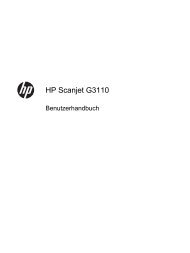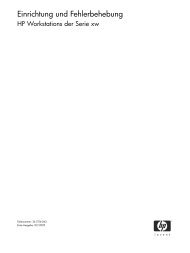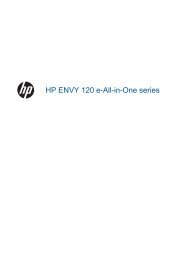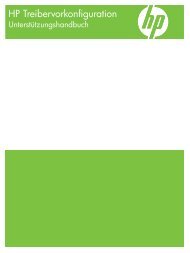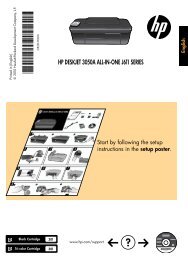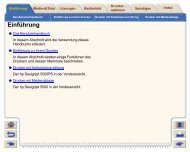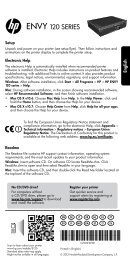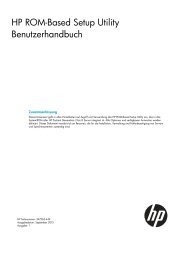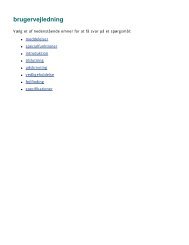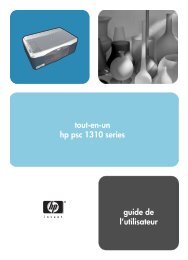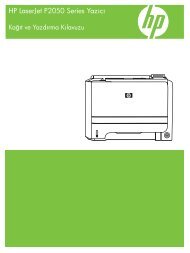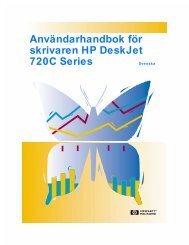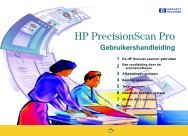HP OfficeJet G Series - Hewlett Packard
HP OfficeJet G Series - Hewlett Packard
HP OfficeJet G Series - Hewlett Packard
Create successful ePaper yourself
Turn your PDF publications into a flip-book with our unique Google optimized e-Paper software.
AvPrn.book Page 54 Wednesday, January 26, 2000 1:39 PM<br />
<strong>HP</strong> <strong>OfficeJet</strong> G <strong>Series</strong><br />
The Telephone Consumer Protection Act of 1991 makes it unlawful for any person to use a computer or other<br />
electronic device, including fax machines, to send any message unless such message clearly contains in a margin<br />
at the top or bottom of each transmitted page or on the first page of transmission, the date and time it is sent and<br />
an identification of the business, other entity, or other individual sending the message and the telephone number<br />
of the sending machine or such business, other entity, or individual. (The telephone number provided may not be<br />
a 900 number or any other number for which charges exceed local or long-distance transmission charges.) In<br />
order to program this information into your fax machine, you should complete the steps described in the software.<br />
Déclarations réglementaires<br />
Vous trouverez ci-dessous des déclarations de divers organismes de réglementation.<br />
FCC statement<br />
The United States Federal Communications Commission (in 47 CFR 15.105) has specified that the following<br />
notice be brought to the attention of users of this product.<br />
Declaration of Conformity: This equipment has been tested and found to comply with the limits for a Class B<br />
digital device, pursuant to part 15 of the FCC Rules. Operation is subject to the following two conditions: (1) this<br />
device may not cause harmful interference, and (2) this device must accept any interference received, including<br />
interference that may cause undesired operation. Class B limits are designed to provide reasonable protection<br />
against harmful interference in a residential installation. This equipment generates, uses, and can radiate radio<br />
frequency energy, and, if not installed and used in accordance with the instructions, may cause harmful<br />
interference to radio communications. However, there is not guarantee that interference will not occur in a<br />
particular installation. If this equipment does cause harmful interference to radio or television reception, which<br />
can be determined by turning the equipment off and on, the user is encouraged to try to correct the interference<br />
by one or more of the following measures:<br />
• Reorient the receiving antenna.<br />
• Increase the separate between the equipment and the receiver.<br />
• Connect the equipment into an outlet on a circuit different from that to which the receiver is connected.<br />
• Consult the dealer or an experienced radio/TV technician for help.<br />
Product Regulations Manager, <strong>Hewlett</strong>-<strong>Packard</strong> Company, San Diego, 619-655-4100.<br />
The user may find the following booklet prepared by the Federal Communications Commission helpful: How to<br />
Identify and Resolve Radio-TV Interference Problems. This booklet is available from the U.S. Government<br />
Printing Office, Washington DC, 20402. Stock No. 004-000-00345-4.<br />
CAUTION Pursuant to Part 15.21 of the FCC Rules, any changes or modifications to this equipment not expressly<br />
approved by the <strong>Hewlett</strong>-<strong>Packard</strong> Company, may cause harmful interference and void the FCC<br />
authorization to operate this equipment.<br />
DOC statement / Déclaration de conformité (Canada)<br />
Le présent appareil numérique n’émet pas de bruits radioélectriques dépassant les limites applicables aux<br />
appareils numériques de la classe B prescrites dans Règlement sur le brouillage radioélectrique édicté par le<br />
ministère des Communications du Canada.<br />
This digital apparatus does not exceed the Class B limits for radio noise emissions from digital apparatus set out<br />
in the Radio Interference Regulations of the Canadian Department of Communications.<br />
Notifications aux usagers du réseau téléphonique canadien<br />
Le label Industrie Canada identifie les équipements homologués. Cette homologation signifie que l’équipement<br />
concerné satisfait à certaines exigences de sécurité, de fonctionnement et de protection du réseau de<br />
télécommunications, spécifiées dans le(s) document(s) couvrant les exigences techniques du matériel terminal.<br />
Le ministère ne garantit pas que l’équipement fonctionnera à la satisfaction de l’utilisateur.<br />
Avant d’installer cet équipement, l’utilisateur doit s’assurer qu’il est permis de le connecter aux installations de la<br />
société d’exploitation de télécommunication responsable. L’équipement doit aussi être installé en utilisant des<br />
moyens de raccordement autorisés. Le client doit savoir que, dans certains cas, le respect des exigences décrites<br />
ci-dessus ne prévient pas nécessairement la dégradation du service.<br />
La réparation d’un équipement homologué doit être coordonnée par un représentant du fournisseur. La société<br />
d’exploitation de télécommunication peut exiger de l’utilisateur qu’il déconnecte l’équipement s’il a effectué luimême<br />
des réparations ou modifications ou si le fonctionnement de l’équipement est défectueux.<br />
54 Chapitre 11—Informations techniques



